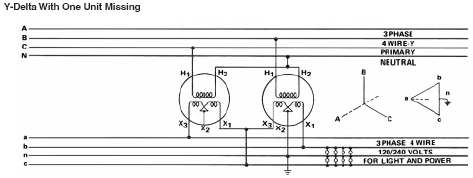- Location
- Wisconsin
- Occupation
- PE (Retired) - Power Systems
John,I have a 240/120 3 phase 4 wire service,
The phase to phase is 240, the phase to ground of my service is 120/120/and about 200. (the high leg). I am have at the service pole behind my transmitter building only two transformers. A 15 KVA and a 37.5 KVA.
The are only two primary high voltage wires feeding these two transformers.
These high voltage wires come from a main service line about 750 feet
from from my building. This main feed has three phases. The power company only brings two of these three phases on to my property. They obtain my three phase service described above from two primary phases and a nuetral. My questions is can anyone supply or direct me to a connection drawing of for this service, with the drawing having the phase notation and an explaination of the generation of the third phase. I think I know how this works, but I want to confirm. I also would like to know the effective KVA of this service. My goal is to change the service to a three transformer, closed Delta service, fed by all three primary phases.
You have an open wye to open delta connection.
There is no direct method to tell you the equivalent three phase transformer capacity that you have.
Open delta 4-wire transformer banks are sized based on the 3-phase load plus the single phase load. So, assuming that typical procedures were followed, you have an open-delta 15kVA transformer for 3-phase 240V loads and 22.5kVA for single phase 120/240V loads.
The closed delta equivalent rating of an an open delta transformer bank are:
For equally sized units (no center tap)
Three Phase KVA Capacity = Total KVA of both units X .86 = KVA of single unit X 1.73
For unequally sized units, a commonly used formula is:
KVA(a) = .58T
KVA(center tap) = .58T + S
where T= three phase load and S = single phase load
For single core three phase units you can use:
KVA = T + 2.5 X (120V loads)
So in your case, you probably have the ability for 25KVA balanced three phase + 22KVA single phase. If I was replacing this with a single closed delta center tapped unit I would use one rated at least 53KVA 240/120 3PH 4W.

